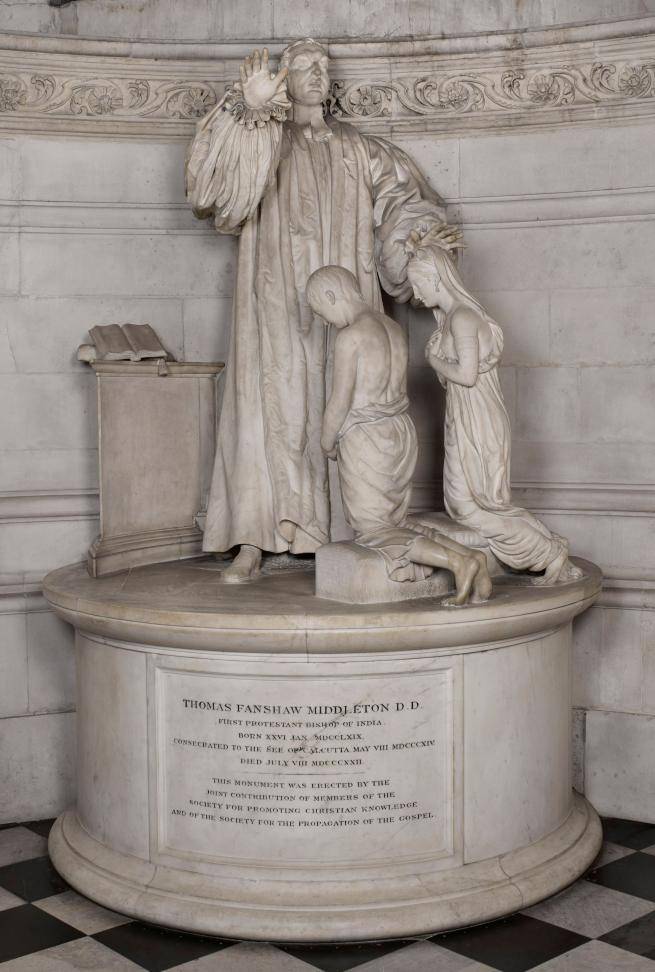Bishop Thomas Fanshaw Middleton (1769-1822): The history

Image courtesy of Pantheons: Sculpture at St Paul's Cathedral.
Bishop Thomas Fanshaw Middleton
1769-1822
The history
Part of The East India Company at St Paul’s: A digital trail produced in collaboration with Stepney Community Trust.
Written by Reverend Canon Dr Peniel Rajkumar, Theologian and Director of Global Mission, United Society Partners in the Gospel.
The following text is available in Bengali, Gujurati, Urdu, Hindi, Punjabi, and Tamil. Please email CollectionsDepartment@stpaulscathedral.org.uk to request a copy.


![]()
The renewal of the East India Company’s charter in 1813 gave rise to considerable debate in Parliament over the place of Christian religious activity in the East India Company’s territories. Ultimately, the Act of 1813 required the East India Company to permit missionary work in India, and a charter was passed through the House of Commons to establish the Anglican Bishopric of Calcutta (Kolkata). Thomas Middleton became the first Bishop of Calcutta, arriving in India in 1815. The monument here was jointly paid for by the Society for Promoting Christian Knowledge and the Society for the Propagation of the Gospel.
What linked Bishop Middleton with the Society for Propagation of the Gospel (SPG) – known today as USPG (United Society Partners in the Gospel) – was a mutual recognition of the transformative potential of education. Middleton had a vision of establishing a mission college in Kolkata that might function as a ‘university of the East’, strengthening on the one hand the Christian formation of young Indian Christians, as well as catering to Hindus and Muslims without any specific religious purposes on the other.
The figures in this statue are kneeling on Victorian-style pew stools (found in historic Anglican churches in India like St Paul’s Cathedral, Kolkata) probably during the rite of confirmation. It is significant to note the absence of visible upper-caste symbols on the boy figure like the shikha (tuft of hair) or sacred thread; equally noteworthy is the presence of the armlet, a symbol of ambiguous caste affiliation, on the girl figure. These features indicate that the young people may not have necessarily belonged to the upper-caste groups. The education work of Anglican mission agencies like the SPG sought to transcended caste boundaries and be a ‘general asylum for the friendless, the destitute, and the rejected children of either Hindoo or Mohamedan origin’, as described by the journal British Critic of which Middleton had served as editor.
Today, the college Middleton founded is called Bishop’s College, an ecumenical theological college run by USPG’s partner, the Church of North India (CNI), which seeks to train men and women to be agents of God's transforming work in the Church and in the world today. Find out more at the Bishop’s College website.
USPG’s work with the Church of North India (CNI) has over the years focused on education, which is widely acknowledged by the Dalits (formerly known as untouchable castes) as an effective means of emancipation from the caste system. The famous Dalit leader, Dr B R (Babasaheb) Ambedkar, whose ancestors had in fact served in East India Company armies, issued a clarion call to Dalits ‘educate, agitate and organise’. You can read about some of the services provided by the CNI to address issues of caste through education.
For detailed information about this monument, visit the Pantheons: Sculpture at St Paul's Cathedral website.

The East India Company at St Paul's
Explore the full digital trail produced in collaboration with Stepney Community Trust.




